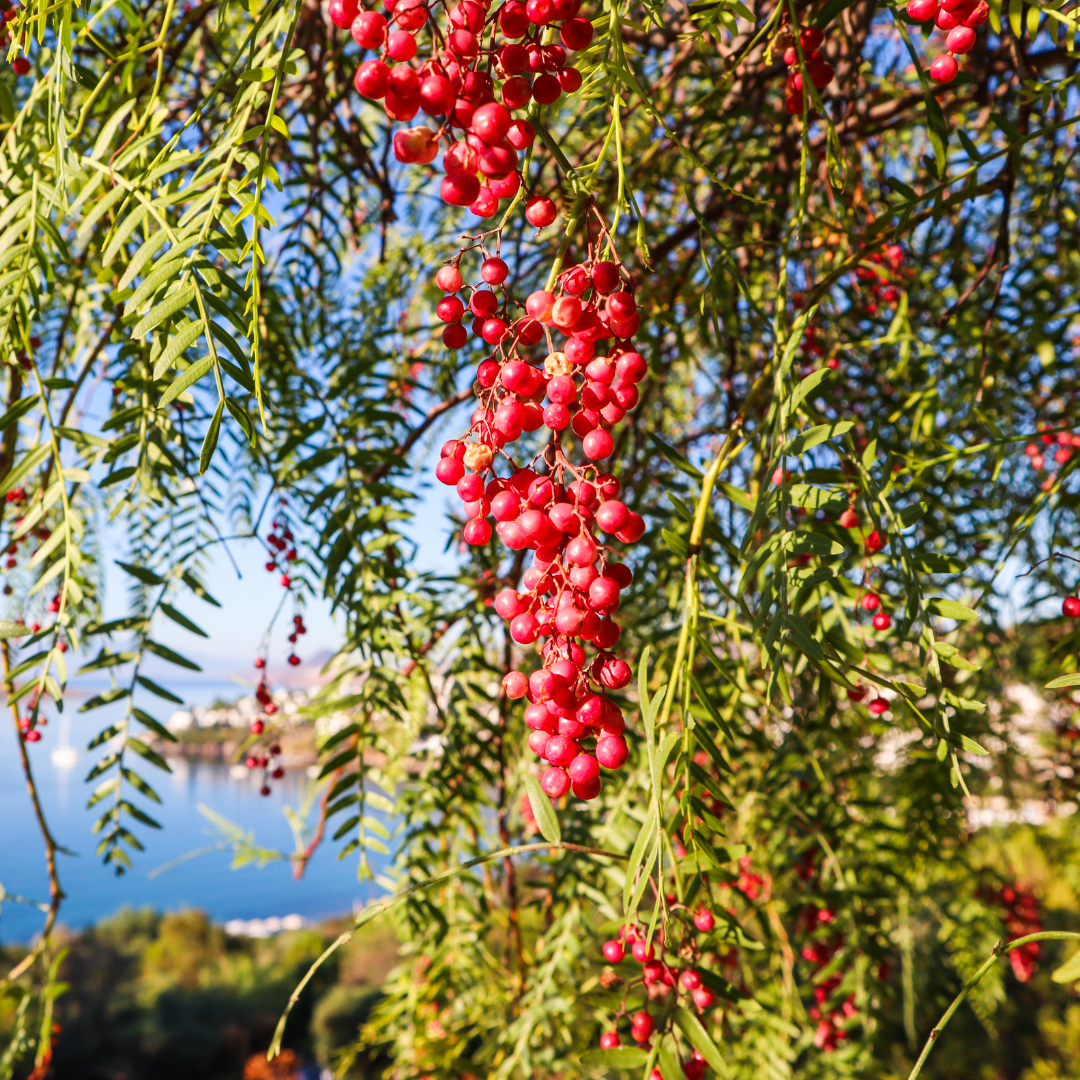My Store
Brazilian Pepper
Brazilian Pepper
Couldn't load pickup availability
Plant Type: tree
Plant Height: 15-30 feet
Spread: 10-15 feet
Flower Color: White
Sun Exposure: Full Sun, Partial Shade
Brazilian Pepper Tree (Schinus terebinthifolius) – Ornamental Appeal with Invasive Risks
The Brazilian Pepper, scientifically known as Schinus terebinthifolius, is an evergreen shrub or small tree native to South America. Known for its bright red berries and aromatic foliage, it’s both admired as an ornamental plant and recognized as an invasive species in several regions, notably in Florida and California. Here’s what you need to know about this plant’s aesthetic appeal, ecological risks, and potential management considerations.
Key Features of the Brazilian Pepper Tree
-
Attractive Berries and Flowers
Brazilian Pepper trees produce dense clusters of small, white flowers in the fall, followed by bright red berries that persist through winter. These berries are a striking feature in landscapes, though they’re also toxic to humans and many animals. Birds are drawn to these berries, inadvertently contributing to the plant's spread. -
Aromatic Foliage
The compound, glossy leaves are deep green and release a peppery fragrance when crushed. This aroma is due to volatile oils within the leaves, adding a sensory aspect to the tree. However, this oil can be irritating to some people and animals, so handling should be done with care. -
Adaptability
Brazilian Pepper is tolerant of various soil types, drought conditions, and salt spray, making it resilient and easy to establish in diverse environments. It can grow to form dense thickets, crowding out native vegetation and altering local ecosystems.
Invasive Potential and Ecological Impact
Due to its adaptability and rapid growth, Brazilian Pepper has become a significant ecological threat in areas like Florida and California. It is known to:
- Displace Native Plants: By forming dense thickets, it competes with and displaces native plant species.
- Alter Habitats: The plant disrupts natural habitats, affecting biodiversity and the availability of resources for native wildlife.
- Spread Aggressively: Birds and other animals disperse the seeds, allowing Brazilian Pepper to quickly establish itself and expand.
In many regions, it is classified as an invasive species and is prohibited or highly regulated due to its ecological impact.
Uses in Landscaping (Where Non-Invasive)
In regions where it is not invasive, Brazilian Pepper can be used as an ornamental plant due to its visual appeal. Its evergreen foliage, striking red berries, and low water requirements make it attractive for specific landscapes. However, responsible management and containment measures are essential to prevent unintended spread.
Considerations for Planting and Management
- Check Local Regulations: Before planting Brazilian Pepper, confirm if it is permitted in your area.
- Plant Responsibly: Consider alternatives if there are native or non-invasive options that provide similar aesthetic qualities.
- Control and Containment: If you choose to plant it, prune regularly, remove any seedlings, and avoid allowing berries to drop near open ground.
Conclusion
The Brazilian Pepper tree is a visually appealing, drought-tolerant option with significant invasive risks. Its bright red berries, aromatic foliage, and adaptability have earned it popularity in ornamental landscaping. However, due to its potential to disrupt ecosystems, caution is advised. Gardeners should carefully assess local regulations, potential ecological impacts, and maintenance needs before incorporating this species into any landscape.
Three Timbers Installation Guide (Feel Free to Follow): Brazilian Pepper
Planting Guide:
- Location: Full sun (at least 6 hours of direct sunlight daily for optimal growth)
- Soil: Well-drained, sandy or loamy soil (slightly acidic to neutral soil preferred)
- Spacing: Space plants 10-15 feet apart to allow for their mature size and optimal air circulation
- Planting Depth: Plant at the same depth as the root ball, ensuring the top of the root ball is level with the surrounding soil surface
- Support: Brazilian Pepper grows as a large shrub or small tree and does not require staking unless the tree is young or top-heavy
Watering Guide:
Watering After Planting:
- Initial Watering: Water thoroughly immediately after planting to saturate the root ball and surrounding soil
- Frequency: Water every 2-3 days for the first 2-3 weeks to help establish the root system
- Watering Amount: Provide 1-2 inches of water per session to ensure deep watering around the roots
When is the Plant Established?
- Timeframe: Brazilian Pepper is considered established after 3-4 months when the roots have spread into the surrounding soil and the plant begins showing consistent new growth
Watering Once Established:
- Summer: Water every 7-10 days during the hotter months. If temperatures exceed 100°F, increase watering to every 5-7 days. Provide 1.5-2 inches of water per session.
- Winter: Water every 3-4 weeks during the cooler months, depending on rainfall. Brazilian Pepper is drought-tolerant once established, but it benefits from occasional deep watering during dry winter periods.
Drip Irrigation Setup:
- Placement of Emitters: Place the drip emitters 18-24 inches away from the base of the tree to ensure that water reaches the root zone and promotes deep root growth.
- Flow Rate: Use emitters with a flow rate of 2-4 gallons per hour for slow, deep watering. This ensures that water penetrates deeply into the soil and supports healthy root development.
- Number of Emitters: Place 2-3 emitters around the base of the plant to ensure even water distribution. Adjust the number of emitters as the tree matures.
- Irrigation Zone: Set up a dedicated irrigation zone for Brazilian Pepper and other trees that require deep watering to ensure they receive proper watering without overwatering.
- Adjusting Frequency: In the summer, increase watering frequency to every 5-7 days to ensure the tree remains hydrated, especially during high heat. In winter, reduce watering to every 3-4 weeks or adjust based on rainfall.
General Watering Tips:
- Soil Check: Check the soil moisture regularly. Water when the top 2-3 inches of soil feel dry to the touch.
- Avoid Overwatering: Brazilian Pepper prefers well-drained soil and does not like sitting in water. Overwatering can lead to root rot, so ensure that the soil drains well and avoid standing water around the base of the tree.
- Mulch: Apply a thin layer of mulch around the base to help retain moisture, keep the roots cool, and reduce weed growth. Avoid placing mulch directly against the tree’s trunk to prevent rot.
Share












